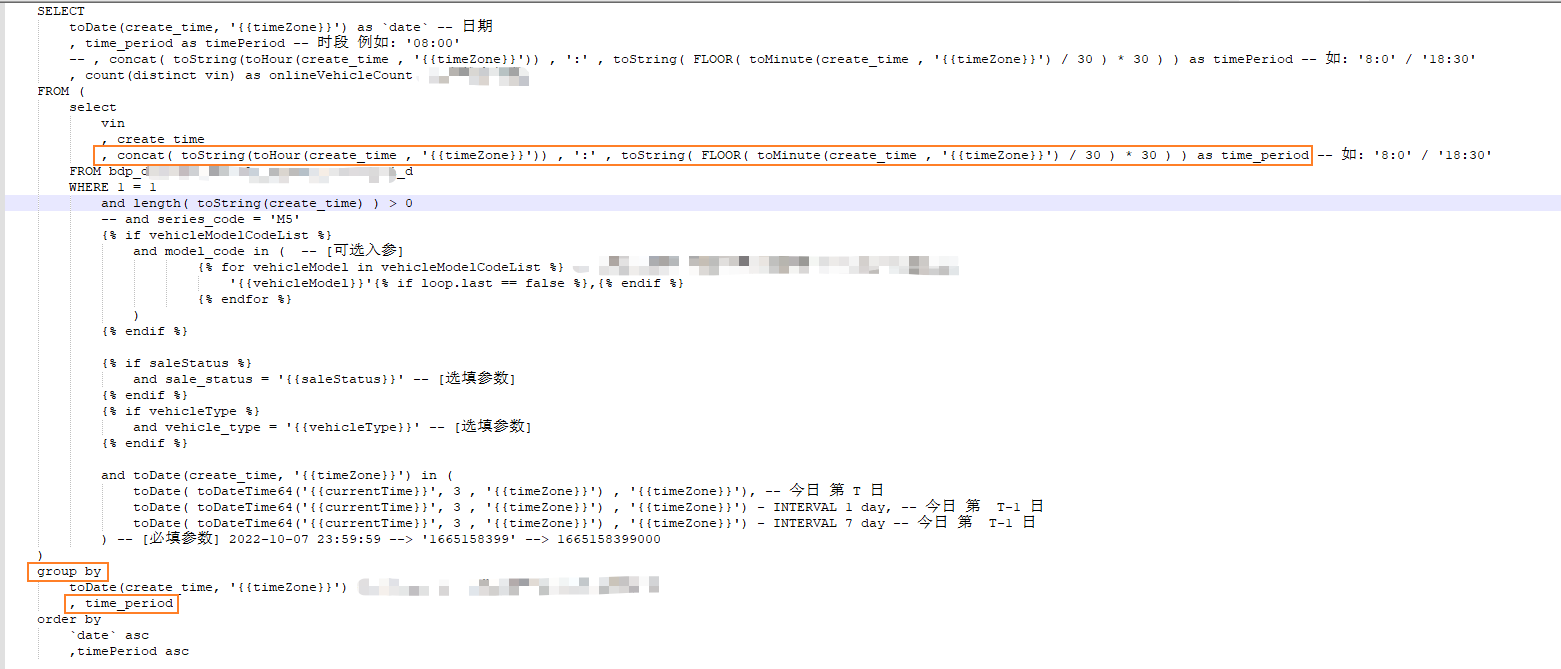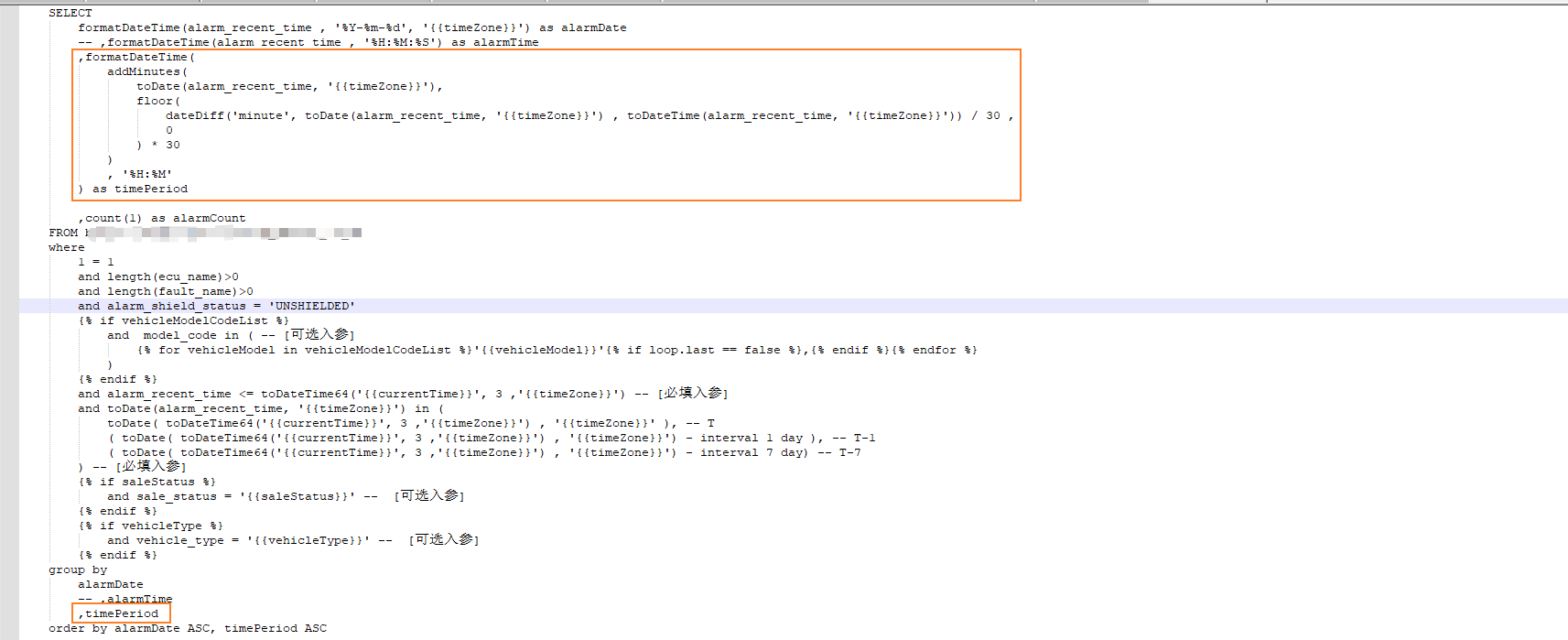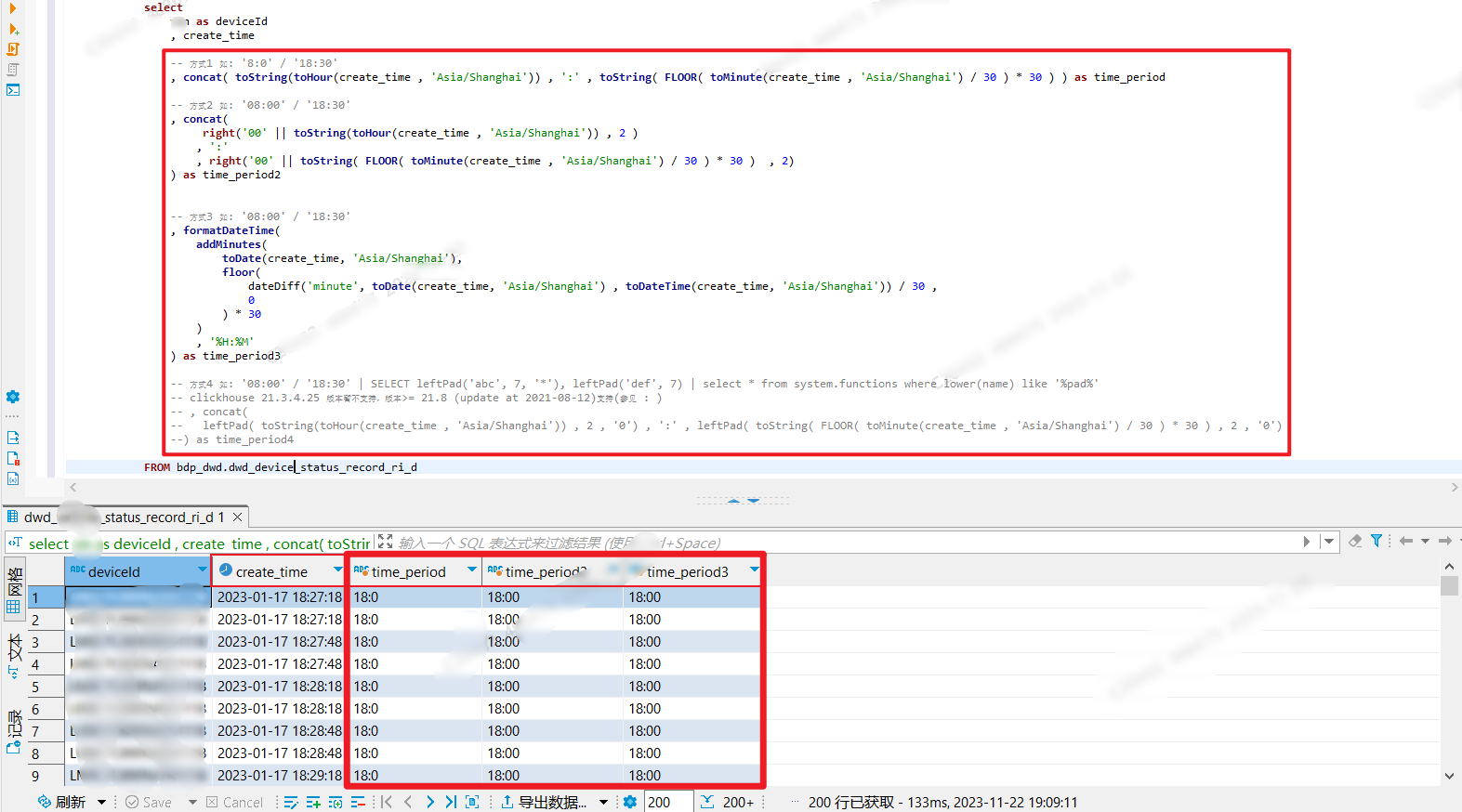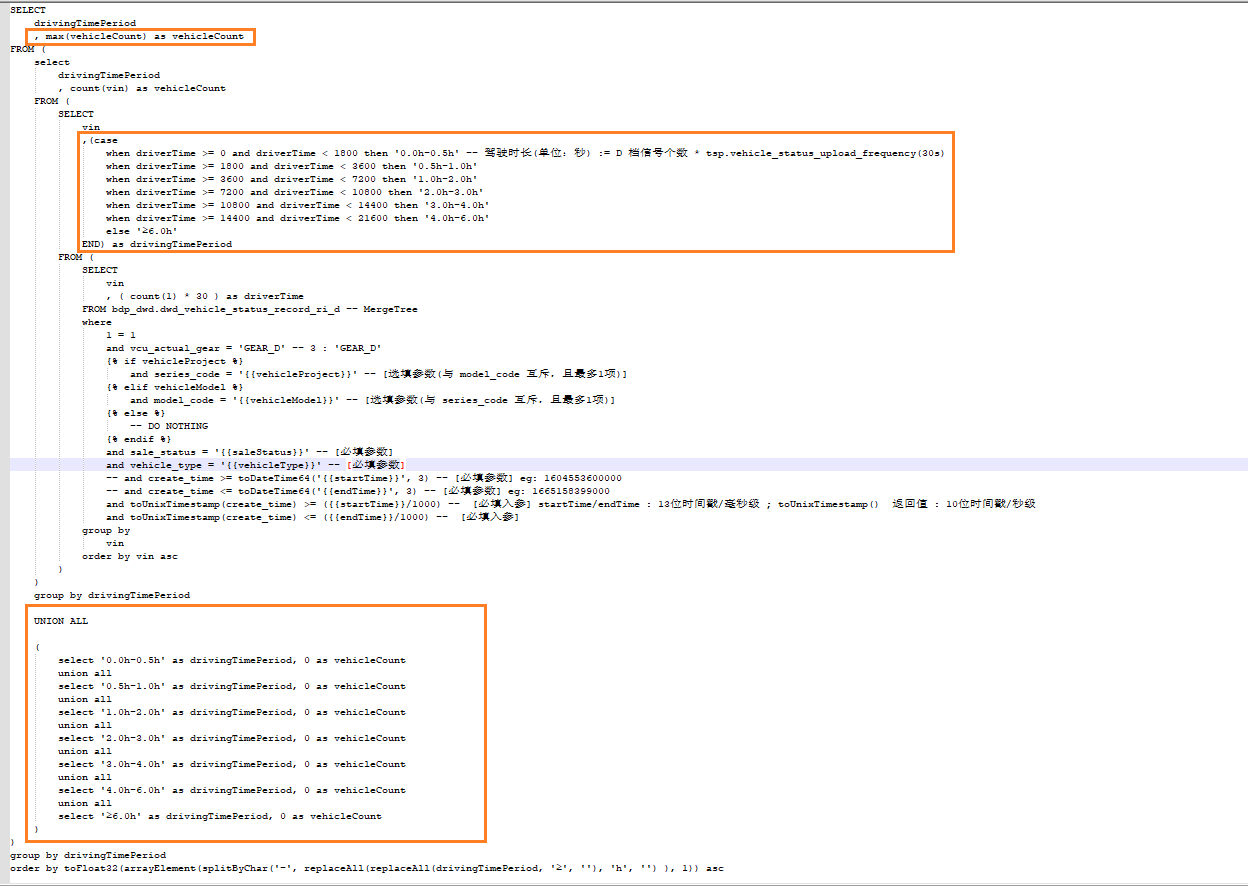[数据库] SQL特定查询场景之时间段切分方法
1 序言
大数据项目、数据分析场景中,Query API/SQL经常遇到需要切分时段的需求。
如下是一些项目上的经验总结。
2 实时数仓即席查询场景的解决方法
2.1 函数拼接法
- 方法特点:
- 时间数据以
时间戳形式存储在数据库,而非以时间字符串- 查询时实时运算时间段
基于此,支持根据终端用户所处位置/时区的不同,而实时计算时间段
- 数据量大、或并发量大时,需考虑数据库的计算资源(CPU、内存)是否充裕
- 案例1
以Clickhouse为例 / eg. timeZone = Aisa/Shanghai
concat( toString(toHour(create_time , '{{timeZone}}')) , ':' , toString( FLOOR( toMinute(create_time , '{{timeZone}}') / 30 ) * 30 ) ) as time_period -- eg. '8:0' / '18:30'

- 案例2
以 Clickhouse 为例 / eg. timeZone = Aisa/Shanghai
formatDateTime(
addMinutes(
toDate(alarm_recent_time, '{{timeZone}}'),
floor(
dateDiff('minute', toDate(alarm_recent_time, '{{timeZone}}') , toDateTime(alarm_recent_time, '{{timeZone}}')) / 30 ,
0
) * 30
)
, '%H:%M'
) as timePeriod


2.1.1 【补充】时段补0问题(如:8:0 => 08:00)

select
device_id
, create_time
-- 方式1 如: '8:0' / '18:30' | 不支持左边自动补0
, concat( toString(toHour(create_time , 'Asia/Shanghai')) , ':' , toString( FLOOR( toMinute(create_time , 'Asia/Shanghai') / 30 ) * 30 ) ) as time_period
-- 方式2 如: '08:00' / '18:30' | 支持左边自动补0
, concat(
right('00' || toString(toHour(create_time , 'Asia/Shanghai')) , 2 )
, ':'
, right('00' || toString( FLOOR( toMinute(create_time , 'Asia/Shanghai') / 30 ) * 30 ) , 2)
) as time_period2
-- 方式3 如: '08:00' / '18:30' | 支持左边自动补0
, formatDateTime(
addMinutes(
toDate(create_time, 'Asia/Shanghai'),
floor(
dateDiff('minute', toDate(create_time, 'Asia/Shanghai') , toDateTime(create_time, 'Asia/Shanghai')) / 30 ,
0
) * 30
)
, '%H:%M'
) as time_period3
-- 方式4 如: '08:00' / '18:30' | 支持左边自动补0
-- SELECT leftPad('abc', 7, '*'), leftPad('def', 7) | select * from system.functions where lower(name) like '%pad%'
-- clickhouse 21.3.4.25 版本暂不支持,版本>= 21.8 (update at 2021-08-12)支持(参见 : )
-- , concat(
-- leftPad( toString(toHour(create_time , 'Asia/Shanghai')) , 2 , '0') , ':' , leftPad( toString( FLOOR( toMinute(create_time , 'Asia/Shanghai') / 30 ) * 30 ) , 2 , '0')
--) as time_period4
FROM bdp_dwd.dwd_device_status_record_ri_d
2.2 查询SQL按不同情况手动分隔时间段
- 方法特点
- 时间以
时间戳形式存储在数据库- 不建议/不适用于需要分几十上百个时段的情况(SQL会非常冗长、易错)
- 案例
以 Clickhouse 为例
...
(case
when driverTime >= 0 and driverTime < 1800 then '0.0h-0.5h' -- 驾驶时长(单位:秒) := D 档信号个数 * tsp.vehicle_status_upload_frequency(30s)
when driverTime >= 1800 and driverTime < 3600 then '0.5h-1.0h'
when driverTime >= 3600 and driverTime < 7200 then '1.0h-2.0h'
when driverTime >= 7200 and driverTime < 10800 then '2.0h-3.0h'
when driverTime >= 10800 and driverTime < 14400 then '3.0h-4.0h'
when driverTime >= 14400 and driverTime < 21600 then '4.0h-6.0h'
else '≥6.0h'
END) as drivingTimePeriod
...
UNION ALL
(
select '0.0h-0.5h' as drivingTimePeriod, 0 as vehicleCount
union all
select '0.5h-1.0h' as drivingTimePeriod, 0 as vehicleCount
union all
select '1.0h-2.0h' as drivingTimePeriod, 0 as vehicleCount
union all
select '2.0h-3.0h' as drivingTimePeriod, 0 as vehicleCount
union all
select '3.0h-4.0h' as drivingTimePeriod, 0 as vehicleCount
union all
select '4.0h-6.0h' as drivingTimePeriod, 0 as vehicleCount
union all
select '≥6.0h' as drivingTimePeriod, 0 as vehicleCount
)
...

2.3 写入数据库时即存储时段字段(timePeriod)
- 方法特点
- 不适用于分不同时区查询/分析数据的情况
因为写入的时段字段是某一个固定的时区,无法在查询时根据不同时区进行查询
3 离线数仓离线查询场景的解决方法
TODO
X 参考文献

本文作者:
千千寰宇
本文链接: https://www.cnblogs.com/johnnyzen
关于博文:评论和私信会在第一时间回复,或直接私信我。
版权声明:本博客所有文章除特别声明外,均采用 BY-NC-SA 许可协议。转载请注明出处!
日常交流:大数据与软件开发-QQ交流群: 774386015 【入群二维码】参见左下角。您的支持、鼓励是博主技术写作的重要动力!
本文链接: https://www.cnblogs.com/johnnyzen
关于博文:评论和私信会在第一时间回复,或直接私信我。
版权声明:本博客所有文章除特别声明外,均采用 BY-NC-SA 许可协议。转载请注明出处!
日常交流:大数据与软件开发-QQ交流群: 774386015 【入群二维码】参见左下角。您的支持、鼓励是博主技术写作的重要动力!

